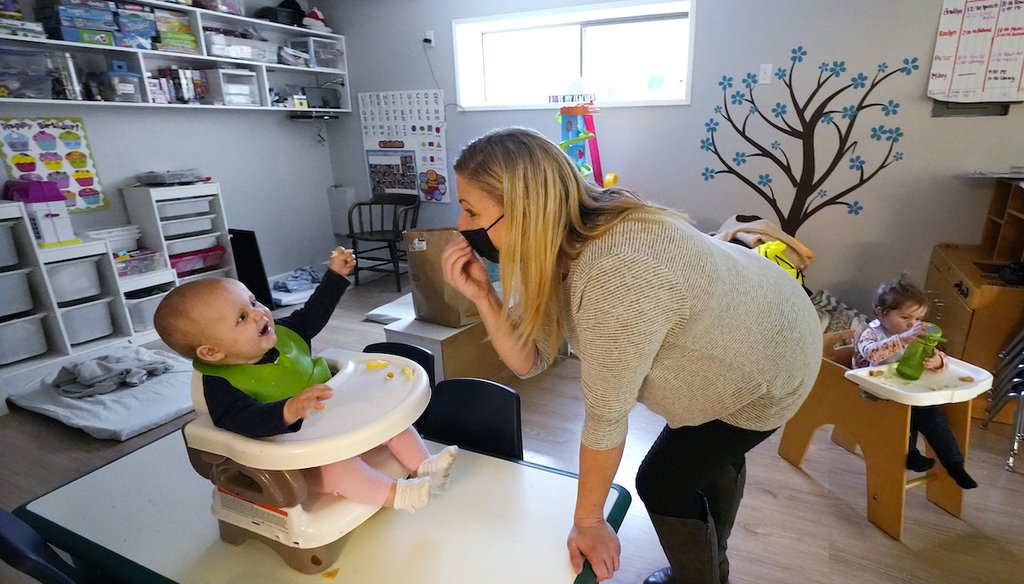Stand up for the facts!
Our only agenda is to publish the truth so you can be an informed participant in democracy.
We need your help.
I would like to contribute

Amy McCoy signs to a baby about food as a toddler finishes lunch behind at her Forever Young Daycare facility on Oct. 25, 2021, in Mountlake Terrace, Wash. (AP)
If Your Time is short
-
The CDC recently revised its developmental milestone checklists for infants and young children for the first time in nearly 20 years.
-
The revision included adjusting the milestone benchmarks to reflect the behaviors and skills that research shows 75% of children at that age typically exhibit. Prior, those benchmarks were indicative of what 50% of children were doing.
-
The CDC and American Academy of Pediatrics said the goal was to help parents more clearly identify issues like autism or other social-communication disabilities earlier.
-
There is no indication that the milestones were updated to cover up negative impacts that the COVID-19 pandemic may have had on children.
In 2004, the Centers for Disease Control and Prevention released developmental milestone checklists for infants and young children to help parents track their child’s development and intervene if it seemed a child was delayed.
The benchmarks, part of the CDC’s "Learn the Signs. Act Early" developmental monitoring program, remained unaltered for decades. But that changed on Feb. 8, when the agency, in partnership with the American Academy of Pediatrics, announced that the milestones had been revised.
Pediatricians and child development professionals say that the changes were long overdue and should make it easier to identify issues like autism or other social-communication disabilities. But the changes brought skepticism from people who suggested the update amounted to an attempt to cover up delays in child-development related to the COVID-19 pandemic.
"The CDC and AAP are quietly changing the development milestones for children….You should be asking yourself why…" read a Facebook post caption along with an image that says "Crawling is no longer a milestone. Walking changed from 12 months to 18 months. Talking changed from 12 months to 15 months."
Another post was more direct and described the changes as "dystopian."
Sign up for PolitiFact texts
"Instead of highlighting the harmful effects (of) masking & social isolation have had on small children, the CDC just lowered the bar. Presto! No impact!" it said.
But there is no indication that the CDC and AAP changed the milestones because of any impacts that the COVID-19 pandemic may have had on children. In the works since 2017, the revisions came in response to parent and educator concerns involving early detection of children at risk for developmental delays.
The new milestones, published in the journal Pediatrics, were developed by a group of child development experts who were asked to revise the checklists — free materials that are shared widely with clinicians, families and early childhood professionals and used as ways to monitor pediatric growth. These milestones explain what kinds of behaviors and motor skills a child should be exhibiting at any given age. In the past, these milestones were created based on what research shows about half of children in a population could be expected to achieve by that age.
But clinicians reported that following the 50th percentile guidelines often disadvantaged families who worried when their children weren’t meeting those developmental expectations.
"In some cases, clinicians and families chose a wait-and-see approach, leading to a delay in diagnosis," the AAP said in a news release announcing the changes.
The newly revised developmental checklists now identify the behaviors that 75% or more of children can be expected to exhibit at a certain age based on data, developmental resources and clinician experience. This gives parents and clinicians a narrower set of criteria to use to help target children who might benefit from interventions.
The result is that while parents of a 12-month-old previously would have been told their child should be starting to talk, the guidelines say that behavior is now expected of babies at 15 months. Because that’s when research shows at least 75% of children are doing so. Similarly, the milestone for walking moved from 12 to 18 months.
"If you share the concern that your child isn’t walking at 18 months when 75% of kids would be expected to, it is more indicative of a possible concern that warrants action. In summary, a missed milestone expected of 75% or more of children is more clearly actionable than a missed milestone expected of only half of children that age."
Dr. Paul H. Lipkin, a member of the AAP Section on Developmental and Behavioral Pediatrics and Council on Children with Disabilities, who assisted with the revisions, said the changes aim to do a better job of opening up continuous dialog between parents and their child’s health care providers.
"The earlier a child is identified with a developmental delay the better, as treatment as well as learning interventions can begin," Lipkin said in the AAP’s press release.
Changes to the guidance include:
-
Adding checklists for ages 15 and 30 months so that there is now a checklist for every well-child visit from 2 months to 5 years of age.
-
Identifying additional social and emotional milestones, like when an infant should start smiling on their own to get an adult’s attention.
-
Providing clinicians with recommendations for open-ended questions to use when talking to families about their children. For example, "Is there anything that your child does or does not do that concerns you?"
-
Revising and expanding tips and activities for promoting child development and health.
The CDC said any claims that allege the update is an attempt to cover for developmental delays caused by pandemic measures like masking and social distancing are without merit.
"The work to revise the milestones has been underway for a couple of years. CDC began discussing the milestones revisions in 2017. The working group who developed the revised milestones began working on it in 2019. The review of evidence and revisions were completed in 2019, and parent testing for understanding and relatability was done in the summer of 2020, " the agency’s González told PolitiFact in an email. "With the revisions, the program aimed to address feedback from parents and early childhood professionals over the years about needing more clarity about when to take action on a possible developmental concern."
"CDC’s milestones are not developmental screening tools," González added. "They were developed to promote developmental monitoring to encourage conversations between parents, doctors, and early childhood providers about child development."
Subject matter experts consulted in the AAP’s review of the milestones include a neurodevelopmental pediatrician, a general pediatrician, a speech language pathologist, a professor of special education and early intervention, a developer of developmental screening tools, as well as developmental-behavioral pediatricians and child and developmental psychologists, the CDC said.
While these revisions are unrelated, preliminary research shows that the pandemic appears to have an impact on infant and child development, but social and economic disparities play a role in who is affected the most.
For example, some babies born in the past two years might be experiencing developmental delays due to a lack of social interaction during lockdowns and stressed out, overworked caregivers not being able to provide adequate one-on-one time.
Some children, however, may have thrived in the pandemic, researchers found, if their caregivers were at home for extended periods and there were more opportunities for siblings to interact.
Our Sources
Facebook post, Feb. 21, 2022
Facebook post, Feb. 20, 2022
Centers for Disease Control and Prevention, CDC’s Developmental Milestones, Accessed Feb. 22, 2022
Pediatrics journal, Evidence-Informed Milestones for Developmental Surveillance Tools, Feb. 8, 2022
American Academy of Pediatrics, CDC, AAP update developmental milestones for developmental surveillance program, Feb. 8, 2022
Washington Post, Developmental milestones just changed for the first time in years, Feb. 10, 2022
CNN, Developmental milestones for children have changed for the first time in nearly 20 years, Feb. 18, 2022
Nature, The COVID generation: how is the pandemic affecting kids’ brains?
Email interview, Joseph Cerquone, senior director of public relations at the American Speech Language Hearing Association, Feb. 23, 2022
Email interview, Belsie González, spokesperson for the Centers for Disease Control and Prevention, Feb. 23-28, 2022












































